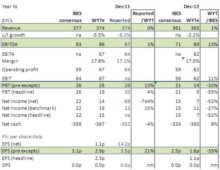Johnston Press (JPR-LN): FY11 results and refinancing – still a poor risk/return, at least for equity

Long overdue results out today which awaited the refinancing. Still looks like a bad mix of high risk and possibly no reward (at least for equity holders – Avoid
Â
Johnston Press            (JPR-LN)
Share price                               5.4p
Growth rating FÂ Â Â Â Â Â Â Â Â Â Â Â Â Â Â Â Â Â Â Â Â +4.8%
Revenue CAGR FY1-3Â Â Â Â Â Â Â Â Â Â Â -1.4%
Target CAGR FY3Â Â Â Â Â Â Â Â Â Â Â Â Â Â Â Â Â +3.4%
Target price                             1.0p
Upside                                      -81%
Recommendation:Â Â Â Â Â Â Â Â Â Â Â Â Â Â AVOID
                           Â
FY11 seems a bit like ancient history with most of its peers having already reported on Q1 FY12, but for what’s it worth, last year’s numbers were broadly as expected with the group dropping just 80bps of adjusted EBITA margins (from 18.1% to 17.3%) on a -6.1% contraction in underlying revenues (WYTe -30bps on -5.5%).This reflected a suitably impressive -16.9% reduction in      underlying costs (-£24.5m like for like before a £7.6m newsprint price increase) and after culling -11.3% from staff numbers (to 5,245).
Summary Results vs WYT & IBES Â Â Â Â Â Â Â Â Â Â Â Consensus estimates

  Â
More pertinent to actual or prospective shareholders however is whether management actions in areas such as digital and publishing frequency (eg the conversion some paid dailies to weeklies) can arrest the rate of structural and cyclical erosion in revenues and  forestall the debt lenders taking what’s left of the value of the business.
On this issue, the jury remains out. H2 2011 digital adverting growth of +8.6% was a start, but still accounts for only 8% of  group advertising and under 5% of overall group revenues. In the  meantime, print advertising continues to be driven by the prevailing market currents, which for thefirst part of 2012 was in  full ebb, as the -10.6% revenue decline that Johnston is reporting for the first 15 weeks confirms. The good news is that national  display advertising markets should firm up over May and June (against easier comparatives and over the Jubilee and Olympics).   Unfortunately for regionals, and in particularly for weekly  focussed publishers such as Johnston, national display represents a relatively small part of its advertising base (we est circa  15%).
Debt refinanced. Year end net debt came in at £352m (down £35m YoY)’ which was slightly better than our £3xx forecast. As  expected, the group has agreed terms with its lenders to secure a £393m 3 year facility to Sept 2015 and replaces the expiring  facility. The terms of the refinancing however is not without  pain. In addition to the interest cost of Libor +5.0% and 10.3% on the loan notes, there is an additional PiK margin (cum) of up to 4.0% based on the outstanding debt at the end of the facility. JP  meanwhile has agreed to repay 70m of this Facility over the 3  years, which at £23m pa and assuming further payments into the pension fund (-£104m at end 2011) does hold out much prospect for a resumption in dividends to shareholders in the meantime.
Over £350m of net debt and costing up to 14% and a pension deficit of £104m adds up to a liability of over £450m even before including future downsizing costs and the proposed warrant issuance to lenders.The question for equity owners therefore must be whether £65m pa of EBITA (and falling) can support even this. On a pre-tax this represents a 14% yield. Post tax and assuming a 90% conversion in cash, this would suggest an operating FCF yield of approx 9%. On our current estimated equity cost of capital this would therefore need to justify a growth rating of around +2% CAGR. With an under-developed digital business land ongoing contraction in industry print revenues this might seem ambitious.  On its current trajectory therefore, equity shareholders may have to rely on the potential value of the tax shield!
What could change? With such high tolerances, the equity valuation is clearly highly sensitive to potentially modest changes in  assumptions.
Potential positives to valuation
1) Consolidation. Even the most brainless regulatory must now accept that migrating advertising to the web is going to kill off many regional titles and if they want to foster consumer choice in local media they need to permit greater consolidation in titles. Although not a solution to the structural shift in revenues, it could add an additional 10ppts + in margins to buy time and help build more resilient online verticals
2) Equity valuations. A fall in equity cost of capital, thru either rising share prices or falling market earnings expectations, would be leveraged thru an over-stretched capital structure. A bit of a long shot at present however.
3) Trading improvements. UK GDP stages a miraculous recovery. OK, so not very likely!

